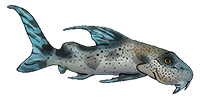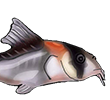| Scientific Name | Liobagrus mediadiposalis Mori, 1936 |
| Common Names | South Torrent Catfish Jagasari (Korean) |
| Type Locality | Rakuto River at Bun-kei, Chosen, Korea. |
| Pronunciation | lie oh BAG russ |
| Etymology | From the Greek, leios, meaning smooth, and bagrus, a name usually used for catfishes; in reference to the smooth head. |
| Articles | |
| Size | 133mm or 5.2" SL. Find near, nearer or same sized spp. |
| Identification | Easily differentiated from the two other Korean Liobagrus species by having an upper jaw that is longer, thus slightly overhanging, the lower jaw. Both L. andersoni and L. obesus have jaws that are of equal length. |
| Sexing | Males have broader heads. Females noticeably plumper during the breeding season. |
| Distribution | Asia: South Korea. Korea Waters (click on these areas to find other species found there) Login to view the map. |
| IUCN Red List Category | Least Concern , range map and more is available on the IUCN species page. Last assessed 2023. |
| pH | 6.5 - 7.5 |
| Temperature | 17.0-25.0°C or 62.6-77°F (Show species within this range) |
| Other Parameters | These fish reside in the temperate zone and undergo a wide range of temperatures throughout the year. They may tolerate higher and lower temperatures for a short period of time. Torrent-like conditions are not necessary, though the water should have some flow. The filter outflow is generally adequate. |
| Feeding | Feeds on small invertebrates and fish in the wild. Adapts readily to prepared food. User data. |
| Furniture | Provide plenty of large stones for hiding places and gravel. Make sure the stones are well set in the substrate as the fish will excavate caves beneath them. This fish has a preference for stones 30-40cm in diameter. Smaller stones will likely be ignored as will artificial caves. Plants are not necessary but floating plants are useful as they dim the lighting. |
| Compatibility | Non-aggressive, but it should not be trusted with small fish and its nocturnal feeding may unintentionally harass other bottom-dwelling species. |
| Suggested Tankmates | It may be kept in groups provided that there are enough suitable rocks for the fish. In nature, they live one per stone, but may cluster, unhapppily, together if there are not enough hiding spots in the aquarium. In nature they have been found sharing their home with Tachysurus fulvidraco outside of breeding time May be mixed successfully with many species of non-tropical fish and occurs naturally with many species of Bitterlings, Zacco platypus,and Phoxinus phoxinus |
| Breeding | While Uchida reported in 1934 that the females guards the eggs, and much available literature still follows his assessment, recent researchers and aquarists suggest that it is the male who guards the eggs. |
| Breeding Reports | There is no breeding report. |
| Reference | Dobutsugaku Zasshi = Zoological Magazine Tokyo v. 48 (nos 8-10), pp 673, Pl. 24 (fig. 3). |
| Registered Keepers | There are 2 registered keepers, view all "my cats" data. |
| Wishlists | Love this species? Click the heart to add it to your wish list. There are 3 wishes to keep this species, see who wants what. |
| Spotters | Spotted this species somewhere? Click the binoculars! There are 2 records of this fish being seen, view them all. |
| Forum BBCode | |
| Search for L. mediadiposalis | |
| Look up L. mediadiposalis on AquaticRepublic.com | |
 | Look up L. mediadiposalis on Fishbase |
 | Look up L. mediadiposalis on Encyclopedia of Life |
 | Look up L. mediadiposalis on Global Biodiversity Information Facility |
| LFS label creator ARN ref:1.18.61.1137 | |
| Last Update | 2025 Jan 02 01:38 (species record created: 2006 Aug 21 02:11) |





/siluriformes/amblycipitidae/liobagrus/mediadiposalis/1.jpg)
/siluriformes/amblycipitidae/liobagrus/mediadiposalis/2.jpg)
/siluriformes/amblycipitidae/liobagrus/mediadiposalis/3.jpg)